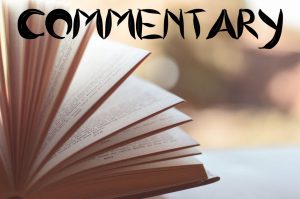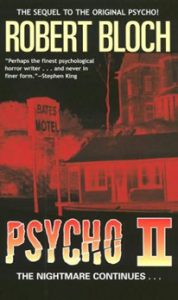In this series, I’m looking back at the books and movies of the “Psycho” franchise before its TV revival in “Bates Motel,” which will conclude its five-season run this month.
More than two decades after 1959’s “Psycho,” Robert Bloch returned to the Norman Bates saga with “Psycho II” (1982), which has more in common with Wes Craven’s “Scream” films – in a good way – than with the film version of “Psycho II” (1983). While some books slap “Now a major motion picture” on their cover despite not particularly resembling the film (“The Lost World: Jurassic Park” comes to mind), reprints of “Psycho II” did not. While the film of the same name came about because of the book’s release, the stories are distinct.
Both before its time and stuck in its time, “Psycho II” is a fascinating read as Bloch becomes fascinated with several controversial ideas: that there’s a little bit of Norman Bates in all of us, that the rise in violence in the early 1980s is related to the success of splatter films of that era, and that Hollywood is a place where people with violent and psychotic tendencies can find careers.
I wouldn’t go so far as to call Bloch’s novel scathing, but nor is it a satire like the “Scream” films. The idea that the “Psycho II” filmmakers rejected the book because it criticized Hollywood is rather amusing considering how tame it is by today’s standards. Before learning that tidbit, I would’ve assumed the limited screentime for Norman Bates was the reason for going in a different direction.
As with the first book, “Psycho II” is a sober character analysis – but of many more characters this time, starting with Dr. Claiborne, who feels guilty for letting Norman escape the Midwestern asylum (again, Fairvale and the surrounding area seem to be in Kansas, but Bloch doesn’t explicitly say so). On the Hollywood set of “Crazy Lady,” a film based on the Bates Motel murders of 23 years prior, we meet stars Paul and Jan, who will play Norman and Mary; writer Ames; director Vizzini; and producer Driscoll.
Similar to the first book, it’s a mystery where the reader only gradually realizes it’s a mystery, and a character study of one particular character without the reader realizing the importance of what we learn until the final reveal.
The early ’80s were the peak years for violent crime in U.S. history — something that was also explored in the 1982-set L.A. serial-killer TV show “Wicked City” (2015) – and it’s clear that this fact was on Bloch’s mind, and that he had no inkling that the trend would dissipate. Today, when many more studies about the nature of violence have been done, Bloch’s theory that people became more violent in that era because of entertainment (specifically splatter films) seems a bit narrow-minded.
However, I’ll let him get away with it for a few reasons: 1, he’s illustrating the thinking of the time, as he also does with references to closeted Hollywood homosexuals; 2, while the “people mimic what they see” theory has been mostly discounted, we can’t say without a doubt what caused the spike in crime; and 3, this isn’t a cynical novel.

By contrast, “Scream 2” (1997), which introduces the in-universe “Stab” franchise, and “Scream 3” (2000), which takes place on the set of “Stab 2,” are cynical films. As good as they may be, those films’ commentaries about Hollywood are winks at an audience that already knows about Hollywood shenanigans. But in his 1982 novel, Bloch seems to be letting readers in on the secrets of Tinseltown, right down to the idea that even Jan – although representing a “pure” actress as opposed to her roommate, a porn actress – has had sex with key people to advance her career. And the characters themselves are well aware of the town’s fake veneer: As Jan observes Driscoll’s office in Chapter 13, she thinks “the décor wasn’t contemporary – just a temporary con.”
Although one could argue that his career was boosted by the cinematic success of “Psycho,” Bloch shows no hypocrisy. “Psycho II” isn’t a particularly blood-soaked novel. Despite featuring more than enough brutal killings to place this firmly in the horror category, the author doesn’t dwell in the grisliness.
(I should digress here and admit that saying the “Psycho” books are “less” violent than an average horror movie of the 1960s, ’70s or early ’80s is subjective. It comes partly from the reality that it’s easier to escape violence in a novel than in a visual medium, because you can effectively self-censor your imagination. Of course, one could argue that the “Psycho” novel’s Shower Scene is “more” violent than the movie version – if one sets aside the insane notion that cold-blooded murder can be different degrees of violent. Norman cuts off Mary’s head, rather than merely stabbing her. Indeed, the books’ killers tend to favor cutting off heads, although there is a variety of murder methods. But ultimately, I’d argue that – considering they are all about violence – the “Psycho” books and films don’t celebrate violence, and that’s why Bloch can get away with the premise of “Psycho II” without being hypocritical. The “Scream” films are hypocritical in that they celebrate violence, but they arguably get away with it by openly admitting their hypocrisy.)
There is a huge chunk in the middle of the book where – despite the tension caused by the fear that Norman Bates may be lurking about the area – no one is actually killed or even harmed. There’s more talk about violence than actual violence, as in Chapter 24 when Vizzini show off the prop room’s weapons collection to Claiborne: “These weapons here – they are a history of mankind.” When Claiborne objects that war is different from non-war violence, Vizzini speaks of the “the looting, the tortures and the killings” that happened in Sicily after World War II had officially swept through. On this point, Bloch is spot on: To categorize governments’ legal (or quasi-legal, as we see today) war violence as a distinct, allowable form of violence is nothing more than semantics or willful ignorance.
Additional tension comes from details such as Claiborne navigating L.A. traffic, but Bloch spends most of his time letting us in on what makes these characters tick. I was particularly struck by the notion that Claiborne, after decades as Norman’s psychologist, had come to see him as a friend in need, rather than as a patient, let alone a killer. While Bloch doesn’t come off as cynical, Claiborne arguably does, as he intends to write a career-making book about how he cured Bates, yet as “Crazy Lady’s” technical advisor, he sides with those who think production should be halted. It’s another meta touch decades before the word “meta” was invented, and it gives “Psycho II” a contemporary quality despite all the tasty 1982 trappings.
As good as this novel is, the marketers seemed as uncomfortable with it as the “Psycho II” moviemakers. While the words on the book’s cover don’t try to trick anyone into thinking the movie’s plot is found inside (aside from the confusing fact that they have the same title), several of the cover artworks do feature the Bates house, even though none of the action takes place there. Indeed, Bloch tells us the motel burned down sometime after Norman’s incarceration.
Bloch’s “Psycho II” isn’t where you would go to find a ton of insight into Norman. You do get some in the early chapters, as the author digs more into the sexual aspects of his dysfunction. But that’s not really a criticism as, from the beginning, Bloch was interested in psychosis in humans, not necessarily in one man, and this theme plays quite well in book form. In a visual medium, people get attached to one character, whether it’s Norman Bates or Jack Bauer. As such, the book series chronicles Psycho No. 2 while the film series goes with a second chapter of Psycho No. 1. While the competing “Psycho IIs” were no doubt mind-bending at the time, decades later it’s fun to follow alternate paths.

